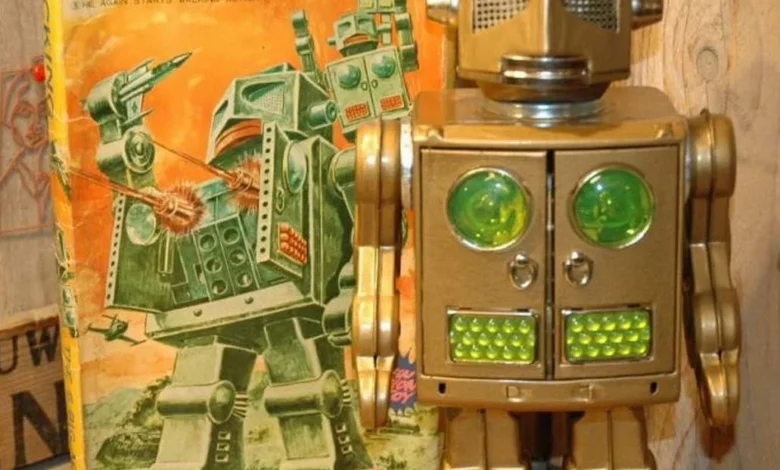What Is the “Attacking Martian”? Origins & Key Facts

The Attacking Martian is a classic battery-operated tin robot toy produced by Horikawa, a well-known Japanese toy manufacturer from the mid-20th century.
-
It debuted around 1962 under the model name TR-259 Attacking Martian.
-
The robot features a chest compartment that opens, double laser guns that light up, and mechanical sound / action effects.
-
It stands ~290 mm height (about 11.4 in) and weighs approximately 621 g in its original form.
-
As a Horikawa toy, it was part of Japan’s booming tin toy era during the 1950s–60s, appealing to both domestic and export markets.
Its name, “Attacking Martian,” evokes mid-century sci-fi fascination with alien invasion, lending the toy a dramatic and memorable identity.
Design & Mechanical Features
What made the Attacking Martian stand out (and still attract toy collectors) lies in its blend of mechanical action, light, sound, and retro design. Here are its key design features:
Mechanical & Battery Action
-
It is battery-operated, meaning internal motors drive movement, often “stop-n-go” walking or sputtering motions.
-
The chest compartment opens to reveal dual laser guns that may light up (i.e. internal bulbs).
-
There is typically a sound effect (shooting noise) at times when the laser guns are active.
Materials & Build
-
The primary material is tinplate (sheet metal) stamped and formed into robot components, common in vintage Japanese robots.
-
Some versions use a white tin battery box and silver metal chest panels.
-
Later versions shifted to using a black plastic battery housing for economy, along with thicker tin arms.
Aesthetic & Style
-
Many models came in silver, gold, or red accents on chest areas.
-
The toy is often boxed in a distinctive red box with graphic images of Martians and dramatic scenes.
-
Proportions include large arms and heavy “robotic” posture, consistent with vintage space-toy tropes.
This combination of action, lighting, tin aesthetics, and sci-fi styling contributes to the enduring appeal of the Attacking Martian among toy enthusiasts.
Variants, Editions & Collectible Versions
Over the decades, multiple variants and editions of the Attacking Martian have emerged. Collectors regard rarer versions as more valuable.
Common Variant Types
-
Big Head / Medallion Versions
Some editions emphasize a larger head or decorative medallion plaques on the chest. -
Lighted Eye / Medallion Lighted Versions
Versions where the robot’s eyes or chest elements light up (LED / bulb) are especially prized. -
Color Variants
Common colors include silver, gold, and bronze or red accents. Some chest panels are red metal in certain runs. -
Battery Box Differences
Early versions used tin battery boxes, later ones used black plastic for cost savings. -
Boxed / Unboxed Editions
Complete models with original box packaging, especially in good condition with graphics, fetch higher values. The boxed Big Head variant is especially collectible. -
Reproductions & Modern Remakes
Some modern toy shops (e.g. Robot Island) offer reproduction wind-up versions in the “Horikawa style,” though not original Horikawa units.
Collectors often identify variants by chest color, battery housing material, arm thickness, and lighting features.
Historical & Cultural Significance
The Attacking Martian is more than just a toy — it reflects the era’s fascination with space, robots, and alien threats, and is a notable specimen in tin toy history.
Role in the Tin Robot Boom
-
During the 1950s–60s, Japanese tin robot toys gained popularity globally, with Horikawa among the prominent manufacturers.
-
The Attacking Martian became a recurring feature in retail catalogs (Spiegel, Western Auto, Aldens) year after year.
-
It tapped into sci-fi culture — alien invasion stories, the Space Age mania, and toy demand.
Museum / Archive Presence
-
Institutions such as the Science Museum Group have catalogued boxed Big Head versions of this robot as part of their toy collections.
-
Enthusiast sites, robot databases, and vintage toy forums maintain detailed pages and histories of Attacking Martian models and catalog appearances.
Collector Appeal & Legacy
-
Because it combines mechanical action, lighting, tin design, and sci-fi branding, it is a sought piece in retro robot / tin toy collections.
-
Its multiple variants create collecting challenges and interest — completing a “set” of all versions is a long-term goal for many.
-
It stands as an icon of post-war toy manufacturing and the intersection of art, mechanics, and pop culture fascination.
Collecting & Care Tips for Attacking Martian Robots
If you’re a collector or thinking about acquiring an Attacking Martian, here are key tips to help you evaluate, preserve, and enjoy your piece.
How to Authenticate & Evaluate
-
Check battery box material: tin or plastic
-
Inspect chest panel color and decals
-
Test lighting / bulb functions (for variants with lighting)
-
Check for arm thickness / style
-
Original box presence & condition dramatically increases value
-
Look for catalog matching in old toy catalogs (Spiegel, Aldens, etc.)
-
Avoid obvious counterfeit or reproduction cases — confirm craftsmanship, patina, and connection details
Preservation & Maintenance
-
Gentle cleaning: wipe dust using a soft, dry cloth; avoid abrasive cleaning of original paint
-
Battery safety: remove old batteries to prevent corrosion or leakage
-
Store in dry, stable environment: avoid humidity and temperature extremes
-
Backup parts: if bulbs or mechanical parts fail, source spare parts from tin toy part sellers
-
Display carefully: use stands or enclosures to avoid tipping or accidental damage
Where to Buy / Source
-
Online marketplaces & forums (eBay, vintage toy auctions) — search under “Horikawa Attacking Martian”
-
Retro toy specialist shops (e.g. Robot Island) selling reproduction or restored models
-
Toy shows / vintage fairs / estate sales — old toys sometimes surface in unexpected places
-
Collector networks & forums — trade, advice, and leads
Value Considerations
-
Complete boxed variants, lighting versions, and rarer colors command premium prices
-
Working condition, originality, and cosmetic condition heavily influence value
-
Expect high price variance depending on scarcity, variant, and collector demand
Why the Attacking Martian Still Matters & Its Pop Culture Resonance
Even decades after its debut, the Attacking Martian remains relevant in several ways:
-
Classic Toy Heritage
It is a representative artifact of the tin toy era — mechanical, imaginative, and evocative of mid-century futurism. -
Inspiration for Modern Design & Reissues
New toy makers and retro brands look back at designs like this for remakes and stylistic inspiration (e.g. the “Horikawa style” reproduction). -
Nostalgia & Collecting Community
Among vintage robot lovers, it remains a benchmark piece. Collecting, restoration, variant hunting, and discussions around the Attacking Martian keep the community active. -
Historical Insight
The toy offers insight into how Japanese manufacturers embraced global sci-fi trends and leveraged them in toy exports. -
Pop Culture Symbol
Its imagery (blasting lasers, chest compartment, “Martian” motif) aligns with iconic alien/robot tropes present in comics, films, and science fiction aesthetics.
Thus, Attacking Martian is more than a toy; it’s a bridge between mid-century culture, mechanical craftsmanship, and modern collector passion.
Conclusion
The Attacking Martian by Horikawa is a fascinating blend of mechanical action, tin craftsmanship, sci-fi theming, and collectible depth. From its origin in the early 1960s to its many variants (big head, lighted, color editions), it continues to captivate vintage toy enthusiasts. Its legacy is sustained not only by nostalgia but by the charm of its design and the stories it embodies — the dreams of space, robots, and the imagination of an era.




